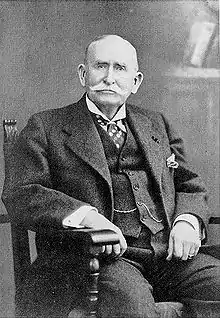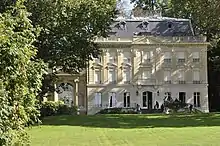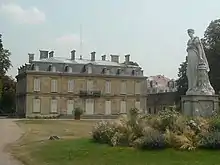Edward Tuck
Edward Tuck (August 24, 1842 – April 30, 1938)[1] was an American banker, diplomat, and philanthropist. He is known for funding the establishment of the Tuck School of Business at his alma mater, Dartmouth College. The son of Amos Tuck, a founder of the Republican Party, Edward Tuck served as the Vice Consul in Paris, and grew his fortune as a partner of the banking firm John Munroe & Co..[2]
Edward Tuck | |
|---|---|
 | |
| Vice Consul of the American Legation in Paris | |
| In office 1864–1866 | |
| Personal details | |
| Born | August 24, 1842 Exeter, New Hampshire |
| Died | April 30, 1938 (aged 95) Monte Carlo, Monaco |
| Spouse |
Julia Stell
(m. 1872; died 1929) |
| Relations | Amos Tuck French (nephew) |
| Parent(s) | Amos Tuck Sarah Ann Nudd |
| Residence(s) | Domaine de Vert-Mont Château de Bois-Préau |
| Education | Philips Exeter Academy Dartmouth College |
| Occupation | Banker, Diplomat, Philanthropist |
| Known for | Tuck School of Business |
| Awards | Legion of Honour Prix de Vertu |
Early life
Tuck was born in Exeter, New Hampshire, on August 24, 1842. He was the son of Sarah Ann Nudd (1810–1847) and political figure Amos Tuck (1810–1879). His half-sister was Ellen Tuck French (1838–1915), who was married to Francis Ormond French, President of the Manhattan Trust Company.
Tuck was educated at Philips Exeter Academy and Dartmouth College, where he roomed with future College president William Jewett Tucker and was a member of Psi Upsilon fraternity.[3][4]
Career
He began his career in 1864, he was appointed by U.S. President Abraham Lincoln as the Vice Consul in Paris under U.S. Ambassador John Bigelow. In the following year, he resigned, shortly before the Franco-Prussian War, and joined the banking firm Munroe & Co., where he was made a partner in 1871.[5]
He retired from banking in 1881, and, in 1889, went to live as an expatriate in France, where he donated an art collection valued at $5 million, and funds for hospitals and other institutions.
Philanthropy
Upon graduating from Dartmouth College, Tuck made a donation of one dollar to the College for "unrestricted use."[5] After his college roommate and longtime friend, William Jewett Tucker, became president of Dartmouth, Edward Tuck became one of Dartmouth's most prolific benefactors. Tuck gave Tuck Drive,[6] an aesthetic bypass and 3,800 ft private highway; the College President's House; the Tuck School, and its grouping of buildings; art works from his private collection; and large cash contributions.[5]
In 1899, Tuck initially donated $300,000 — in the form of 1,700 shares of preferred stock in the Great Northern Railway Company of Minnesota — to Dartmouth to endow the Amos Tuck School of Administration and Finance, in memory of his father.[7][8] He then donated another $100,000, in 1901, to build the first Tuck Hall (now McNutt Hall). In 1929, after solicitation from Ernest Martin Hopkins, the 11th President of Dartmouth, Tuck donated 600 shares of Chase National Bank, which was sold for $567,766. His gifts to the Tuck School are estimated at over $18 million as of 2017.[9]
Other recipients of Tuck's philanthropy included two hospitals (including Stell Hospital[10]), a school, the American University Center in Paris, art collections in France, and the restoration of Roman monument, Tropaeum Alpium. In addition, he donated funds to the New Hampshire Historical Society to build its New Hampshire History Building housing the Tuck Library, and donated to his alma mater, Philips Exeter Academy.[5]
Personal life



In 1872, Tuck married Julia Stell of Philadelphia, for whom Stell Hall, the dining hall at Tuck School is named.[11][5] As a country residence, Tuck lived at Domaine de Vert-Mont and Château de Bois-Préau, near Château de Malmaison and the western bank of the Seine in Rueil-Malmaison. The home was formerly owned by Empress Joséphine, wife of Napoléon Bonaparte, and Queen mother Maria Christina of the Two Sicilies, widow of King Ferdinand VII of Spain who lived there with her second husband Agustín Fernando Muñoz, Duke of Riánsares, until she sold the home in 1861 to Napoleon III.
Tuck's wife died on November 12, 1929.[1] He died on April 30, 1938, in Monte Carlo, Monaco.[1] His funeral was held at the American Cathedral in Paris,[12] and he was buried alongside his wife at the Saint-Germain-en-Laye cemetery.[13]
His estate was valued at $3,514,487 at the time of his death.[14][15]
Legacy
In 1929, Tuck received the Grand Cross as a promotion in the Legion of Honour, the highest award in the Legion the French Government can bestow.[16] The Tucks were also awarded the Prix de Vertu by the French Academy in 1916, the first Americans to receive the award.[1] In 1932, Tuck was made an honorary citizen of France, the highest honor the government could give.[17]
In Paris, Avenue Edward Tuck runs a short distance between the Petit Palais and the Place de la Concorde, parallel to the Avenue des Champs-Élysées.[13] In La Turbie, France, a street is also named Rue Edward Tuck.[17]
In Rome, the Edward Tuck Museum, on the site of the Tropaeum Alpium, documents the restoration of the monument, of which Tuck funded.
Asteroid 1038 Tuckia is named after him and his wife.[18]
.
References
- Notes
- "EDWARD TUCK DIES; PHILANTHROPIST, 95; One of Leading Americans in France, Famed There for Many Benefactions GAVE MUCH TO DARTMOUTH Contributions to College Ran to Millions--Honor Legion Gave Him Grand Cross Honored by France. Gave Millions to Dartmouth Native of New Hampshire Aided National Museum Praised by Dartmouth Leader". The New York Times. 1 May 1938. Retrieved 14 February 2018.
- "Tuck, Edward". nhhistory.org. New Hampshire Historical Society. Retrieved 14 February 2018.
- "Notes from the Dartmouth Library Special Collection". Dartmouth College. Retrieved 14 February 2018.
- "Mr. Tuck 75 Years After Graduation | Dartmouth Alumni Magazine | June 1937". Dartmouth Alumni Magazine | The Complete Archive. Retrieved 2023-08-09.
- Cramer, Kenneth C. "Mr. Edward Tuck". www.dartmouth.edu. Dartmouth College. Retrieved 14 February 2018.
- Meacham, Scott (June 2008). Dartmouth College: An Architectural Tour (1st ed.). New York, NY: Princeton Architectural Press. p. 171. ISBN 978-1568983486.
- "GIVES $300,000 TO DARTMOUTH.; Edward Tuck, the Donor, Provides that It Shall Be Used for Instruction Solely". The New York Times. 20 September 1899. Retrieved 14 February 2018.
- Dartmouth, Tuck School of Business at. "Tuck School of Business | History". www.tuck.dartmouth.edu. Retrieved 14 February 2018.
{{cite web}}:|first1=has generic name (help) - "About Tuck: Our History". Tuck School of Business. Archived from the original on 2007-05-24. Retrieved 2007-11-08.
- à 00h00, Par Frédéric MouchonLe 24 janvier 2004 (2 January 2004). "L'hôpital Stell fête son centenaire". leparisien.fr (in French). Retrieved 28 July 2020.
- "Edward Tuck Devotes His Wealth to France; Edward Tuck". The New York Times. 1 September 1929. Retrieved 14 February 2018.
- "FRENCH PAY TRIBUTE AT FUNERAL OF TUCK; Philanthropist's Life Praised by Many Leaders in Paris". The New York Times. 7 May 1938. Retrieved 14 February 2018.
- "TO NAME STREET FOR TUCK; Paris to Honor Late American Philanthropist --Rites Fridayday". The New York Times. 4 May 1938. Retrieved 14 February 2018.
- "MANY REMEMBERED IN WILL BY TUCK; Philanthropist, Who Died in France, Made Gifts to Friends, Public KIN CHIEF BENEFICIARIES Nephew and Grandniece Get Largest Share in Residue of the Estate Homestead Left to Niece Those Named in the Will Boys Club Shares in Estate L. F. Straus Left $2,736,392". The New York Times. 28 May 1938. Retrieved 14 February 2018.
- "$751,455 IN TUCK ESTATE; Philanthropist Left $3,514,487 in 1938, Accounting Shows". The New York Times. 11 November 1941. Retrieved 14 February 2018.
- "France Honors Edward Tuck". The New York Times. January 30, 1929. Retrieved 14 February 2018.
- Tardiff, Olive. "He Gave Away Millions". Lane Memorial Library. The Exeter News Letter. Retrieved February 22, 2018.
- Schmadel, Lutz D. (2007). "(1038) Tuckia". Dictionary of Minor Planet Names – (1038) Tuckia. Springer Berlin Heidelberg. p. 89. doi:10.1007/978-3-540-29925-7_1039. ISBN 978-3-540-00238-3. The name was proposed by Mme. Gabrielle Camille Flammarion in honor of Mr. and Mrs. Tuck, "generous friends of humanity and of France, benefactors of the Juvisy Observatory, of the Institut d'Optique and of so many other useful works" (L’Astronomie, Vol. 41, p. 229 (1927)).
- Sources
- 1939 Britannica Book of the Year (Chicago: Encyclopædia Britannica, Inc.), p. 673.
External links
- Edward Tuck at Find a Grave
- The Papers of the Tuck Family at Dartmouth College Library
- Franklin Brooks Collection on the Life of Edward Tuck at Dartmouth College Library